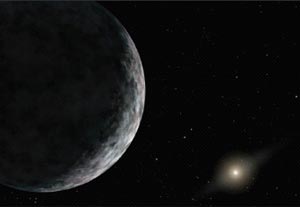A planet larger than Pluto has been discovered orbiting the Sun at more than three times the current distance from the Sun to Pluto. It is a clear member of the Kuiper belt of objects beyond the orbit of Neptune, but being the largest known, it might become recognized as the 10th planet of the solar system.
This new planet, temporarily called 2003 UB313, was discovered with the Samuel Oschin Telescope at the Palomar Observatory by Mike Brown from the California Institute of Technology and colleagues. It is one of around 80 bright objects so far found in the Kuiper belt by an ongoing survey of the outer solar system that started in 2001.

The object appeared in three consecutive image frames of a small portion of the sky taken on 21 October 2003. However, it was so far away that its motion was not detected until the team reanalysed the data in January of this year. Its discovery was announced hastily on 29 July 2005, because of fears that someone could steal the discovery by pointing a telescope at the position of the new planet, which was found to be accessible on the Web.

The planet is currently at a distance of 97 AU (1 AU is the Sun-Earth distance) as deduced from its observed velocity across the sky. However, its highly eccentric orbit will make this reduce to 38 AU – just within the average Sun-Pluto distance – in about 280 years. The size of the planet depends on the amount of light it reflects. If it is reflecting 100% of the Sun’s light, it is the same size as Pluto; but it is more likely that it reflects, as Pluto does, only 60% of sunlight, in which case its diameter must be 2860 km, exceeding Pluto’s size by 25%. This estimate is corroborated by the similarity of the new planet’s infrared spectrum to that of Pluto, as measured by the Gemini telescope on Hawaii, thus suggesting a similar surface covered with frozen methane.
Is it really the 10th planet? Pluto and the new object are clearly very different from the eight other planets. They have eccentric orbits that are tilted with respect to the orbital plane of the other planets by 17° for Pluto and 44° for 2003 UB313. Their distance and size make them the biggest of more than 100 icy bodies beyond Neptune detected so far in the Kuiper belt.
On the other hand, Pluto is so well established as the ninth planet that it will probably keep this status. So will the number of planets stop at Pluto, or will a planet be defined as a body bigger than Pluto? If it were certain that this would be the last such object, it would be tempting to count it as the 10th and ultimate planet in the solar system, but this is likely to remain open for several years.
The final word will be given by the International Astronomical Union (IAU), which will also decide on the planet’s name. Persephone is the wife of Hades (Pluto for Romans) in Greek mythology, but this name and the Roman equivalent Persipina have been attributed to the 26th and 399th known asteroids respectively. The new name proposed to the IAU by the discoverers, but not yet announced, is most probably from a different mythological or spiritual tradition.
Further reading
Seewww.lilahsplanet.com/ (Mike Brown has a baby daughter named Lilah).








